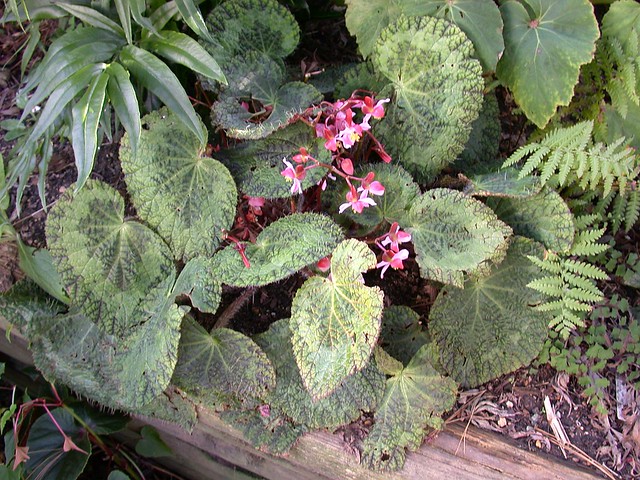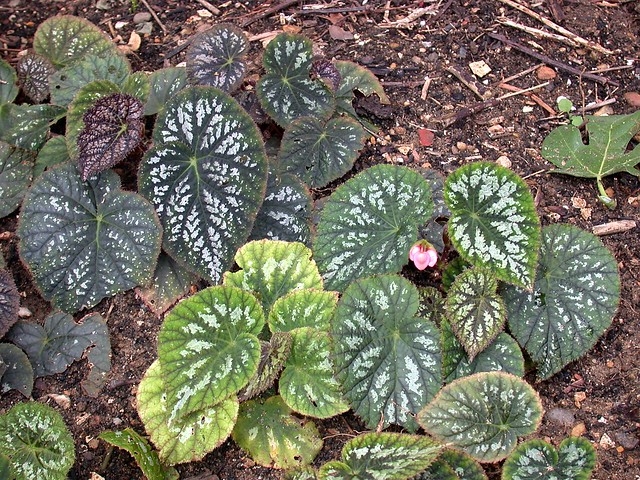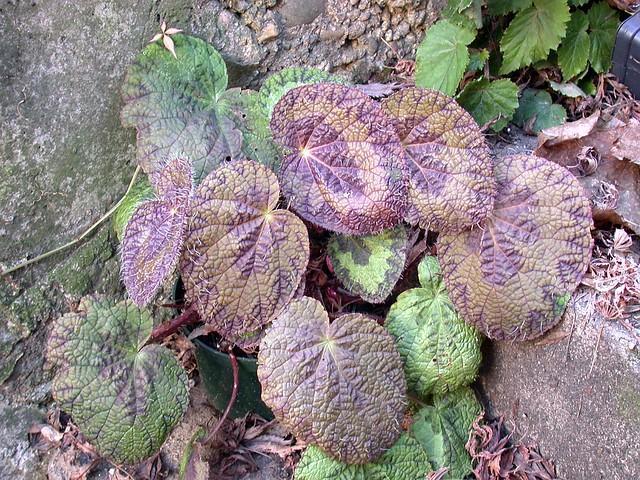
Begonia sizemoreae (female flowers)
With temperatures dropping and the growing season coming to an end, I was going through some old photos for a blog post I'm putting together and came across some photos of a plant I no longer grow, Begonia sizemoreae. This recently described species from northern Vietnam is closely related to B. rex (and according to some botanists the two belong to the same species). I picked up this plant on a whim at a local begonia society show and grew it for a few years; while it didn't turn out to be the least bit hardy, it did give me some interesting hybrids that survived a couple of warm winters in the ground and encouraged me to attempt more crosses.

Begonia sizemoreae in the garden (October 2010)

Begonia sizemoreae hybrids (B. grandis × B. sizemoreae)
Begonia sizemoreae is an extremely variable species, and there's some question as to whether more than one collection or clone is in cultivation. Perhaps some of this variation has emerged in seed-grown plants, uncovering hidden genetic heterozygosity. But there's another explanation: culture. This was brought home to me rather dramatically when I looked at photos of the same plant taken at different times during the year. Compare this photo from the summer:

Begonia sizemoreae (early July 2011)
with this photo of the same plant, taken in early December after a long period of cool temperatures:

Begonia sizemoreae (10 December 2011)
It's hard to believe this is the same plant. Not only is the color different, but the intensity and contrast of the pattern as well. I've discovered that many other begonias can vary quite a bit depending on cultural conditions, and in this case it's probably temperature-related.
Our first hard freeze came unusually late that year. Many begonias are fairly cold-tolerant and will look good right up until frost, but once it freezes, they're done in a dramatic way. Here's the plant the very next morning, after a hard freeze of 29 degrees (F); it collapsed in a pile of mush as soon as it thawed:

Begonia sizemoreae (11 December 2011, at 29 degrees F)
Even so, not all the leaves froze; I was impressed that the concrete steps and wall apparently radiated enough heat to keep some of the leaves from freezing. The plant actually survived this freeze with no damage to its rhizome, but shortly after this I gave up on the species to make room for some of the hardier ones that I'll be writing about in my next blog post!

A nice prelude to your hardier begonias post which we're looking forward to already!
ReplyDeleteNever say never, I have a feeling you're going to get me hooked on begonias...
ReplyDeleteInteresting. I'd no idea that cultural conditions had such a dramatic effect on begonia leaf coloration. sizemoreae is a beauty!
ReplyDeleteSaved some treasured coleus one year, replanted in the spring in a different location, and swear it was a completely different plant. Culture matters I guess, for some.
ReplyDeleteRay
Sizemorea is holding up under fleece in cold wet Manchester, England with fleece protection. Lowest temp so far -1centigrade with a forcast of -3 overnight monday and daytime -1.
ReplyDeleteB. Palmata, pedifeda, grandis, silver splendor and others hardy here. Silver splendor always looks frazzled at leaf edges even in our cool summers, B. Taliensis green form looks ok.
Have not managed to establish little brother montgomery nor connir boswell but due to getting cutting settled. Benichobeba is defoliated but canes look ok.
B. Sinensis disappeared below ground in unusual heat this summer will have to see if it comes back.
Would like to try torsa and the spotted form of grandis but don't seem to be available in uk
Very cool summer for 2015 some plants did not come through til august and many begonias have faiiled to flower including evansiana. The sizemoreae came cack weakly in august but struggled to put on growth, sutherlsndii came back. Palmata as usual was a stalwart, pedatifeda did not flower this year. Connie boswell and little btother montgomery have been longer in ground but not really put on growth, garden angel plum and silver look more estalished. Taliensis is much larger plant than expected as was b. Both formed flowers late in october no females, u614 flowered very lightly throughout summer again all male. Oddly the plant I gave to a neighbour grrew better in a more shaded position getting taller with lotd mote flowers. Labordei and rubella have grown well former flowered later very late to come through in pot when it held enough moisture. Xanthina (wrong name) leafed well and will make good hybrids if it survives. Benitcobiba and cucullata came back very late and weakly rootstocks had rotted despite winter bring wsrm and dry- moved what came thtough to raised bed after stripping away sodden peat based compost. Palmata snow splash (wrongly named formosana spotted leaf?) 2 plants grew well 3rd not so well , palmata dark star (wrongly named possibly xbulimontana) grew less well. Pedatifida rouge nerve (wild cillected torroco taiwan) 2 rotted in pot before could be planted out 3rd came back weakly from deep rhizome. Many others to tell about but first frost may arrive at weekend and will take all top growth down in some parts of uk. Dawn frosts have not arrived locally until mid-late december here many begonias will hold up well until then although sinensis and some others have already defoliated evansiana is quickly following..
ReplyDeleteHi tthanks for posting this
ReplyDelete